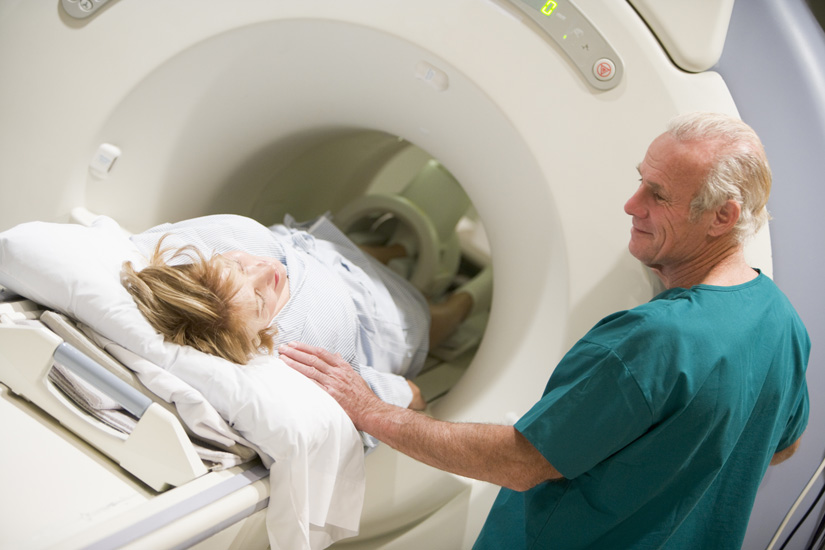Is radiation safe?
Radiation occurs naturally and comes from sources all around us, including our own bodies. Radiation is often misunderstood, but helps to save lives and cure disease.
Radiation is natural and found everywhere – it comes from outer space, the air we breathe, and the earth we tread. It’s even in our bodies; naturally occurring radioactive elements in our bones irradiate us on average 5000 times per second. Sleeping next to someone gives us a much higher radiation dose than living close to a nuclear power station – both of which are harmless.
Life itself emerged at a time when the planet was much more radioactive than it is today, and all living organisms have evolved in ways to be able to coexist with radiation. Many find radiation scary, especially when it is associated with a nuclear power station, despite the fact that there is no difference between natural radiation and ‘man-made’ radiation. After an incident involving radiation, many become anxious because they cannot see, touch or smell it. Because we cannot sense radiation, we rely on different interpretations and portrayals of it to try and understand it – popular culture has played a significant role in shaping the way many of us relate to radiation.
Radiation all around us
On average, we all receive between 2 and 3 millisieverts (mSv) of radiation every year, but this varies considerably around the world due to factors such as altitude and the composition of the ground.
For instance, the radiation dose in Shanghai, which sits at sea level, is lower than in Denver, which sits at an elevation of 1610m. This is due to the fact that the atmosphere reduces the amount of radiation from space that we are exposed to. Denver, sitting at a higher altitude, receives more radiation due to a thinner atmosphere. Equally, flying exposes you to higher doses of radiation as the atmosphere is considerably thinner at 12,000 metres above the sea.
Bedrock geology can also play a major role in background radiation levels. Many areas of the world, such as Kerala (India), Yangjiang (China), and Guarapari (Brazil), have background radiation levels 10-20 times higher than the global average. In Ramsar (Iran), residents can receive doses of up to 260 mSv per year, about 100 times the global average, due to naturally occurring radioactive elements. However, there is no evidence of any adverse health effects in these areas. Many of these areas actually have higher radiation levels than many parts of the evacuation zones around Chernobyl and Fukushima. In fact, most areas of the Chernobyl and Fukushima evacuation zones have radiation levels no higher than natural background levels.

It is estimated that flight crews receive an annual occupational radiation dose of over 3 mSv, much higher than the annual dose recieved by nuclear workers (Sources: The National Council on Radiation Protection and Measurements; Health & Safety Executive)
A person’s background dose is also dependent on individual lifestyle (e.g. number of flights or medical procedures). Cancer patients often receive extremely high radiation doses – in some cases 40-60 Sievert over a period of a few weeks – to treat their disease. Cancer treatments focus on a specifically-targeted part of the body – which the body can cope with – whereas an identical dose over the whole body would be fatal.
Building materials can also emit radiation. Many buildings made out of granite are radioactive, due to the fact that granite contains uranium.

If the US Capitol Building in Washington, D.C. were a nuclear facility, it would not have been licensed due to the radiation levels the buildings gives off.
Radiation and human health
The main negative health effect that people often associate with radiation exposure is cancer. Whilst many believe that all it takes is a single exposure to radiation for cancer to develop, this is not true. Because we are constantly surrounded by radiation, our bodies have developed sophisticated protection mechanisms against its effects. The health impacts of radiation is well understood and studied. The relationship between radiation exposure and cancer has been researched extensively for more than 100 years and it has been proven that radiation is only a weak carcinogen – in other words, it takes a very large amount of radiation to increase the risk of cancer only slightly.
Exposure to radiation is the principal public concern in the event of a nuclear accident. The worst nuclear accident in history, which took place at Chernobyl, caused the death of 28 nuclear plant and emergency workers who were exposed to lethal amounts of radiation. Many of them received doses above 10 Sievert (10,000 mSv) within minutes or hours.
Since the accident in 1986, Chernobyl also resulted in about 6500 thyroid cases – which would have been prevented if the authorities had stopped contaminated foodstuffs from entering the food chain. These cases have, to date, resulted in 15 deaths. In comparison, air pollution from the use of coal kills about 80 people - every hour - in China alone.
Neither of the accidents at Three Mile Island nor Fukushima Daiichi – the only other civil nuclear power plants that have suffered accidents resulting in a noteworthy release of radioactive material into the environment – resulted in any radiation-induced health effects.
Radiation saves lives
Every year, nuclear medicine helps doctors diagnose and treat tens of millions of people. Using radiation, such as X-rays, doctors can make quick, non-intrusive and accurate diagnoses of a patient’s organs. Radioisotopes, which can be produced by commercial power reactors, are used as ’tracers’ in PET scans, which have proven to be the most accurate means of detecting and evaluating most cancers. Radiation can also be used as a non-invasive alternative to brain surgery.

Radiation can also cure cancer and other life-threatening conditions. There are numerous different treatment options, either using external or internal radiation, with the aim to control or eliminate the cancer by irradiating the area containing it. One example is brachytherapy, where small radiation sources are placed inside the body, either inside or nearby the area that requires treatment. It is used to treat many different types of cancer, including breast, prostate and lung.